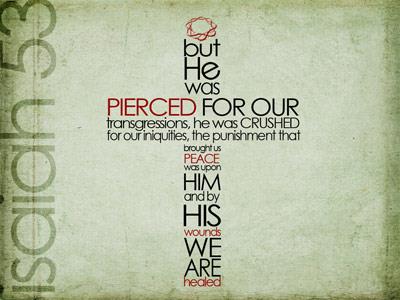-
The Cross Series
Contributed by Garth Wehrfritz- Hanson on Nov 28, 2017 (message contributor)
Summary: The cross is the central symbol of Christianity. It reminds us of humankind’s sinfulness and of God’s love and power to save us.
Sermon for Good Friday, Year C
Based on Isa. 52:13-53:12 & Jn. 19:17-42
By Pastor Garth Wehrfritz-Hanson
“The Cross”
The cross…All of us here today, along with the writers of our scripture passages from Isaiah and John; indeed, the whole world share one thing in common—the cross. We, along with our authors of scripture share the cross in common because of its loving and saving power. We share the cross in common with the whole world because our sinfulness—along with the world’s—continues to crucify Jesus.
The cross is the central most important symbol of Christianity—for good and for ill. Churches in the past were often built in the shape of a cross. People buy and wear all sorts of crosses. Some are silver; gold or jeweled to symbolize how precious and valuable Christ’s suffering and death on the cross was for us. Others are made of wood—some of which are very knotted, twisted and rough to symbolize the folly, the offensiveness and ugliness of Jesus dying on the cross.
In Lutheran churches—as well as in many other denominations’ churches—there is usually a cross hanging on the front chancel wall. Crosses also adorn altars and baptismal fonts. Many Christians also have crosses hanging on the walls of their homes. Christian artists have been—and continue to be—fascinated with the crucifixion of Christ. Christian writers have written countless poems, hymns and books on the crucified Christ. Many Christians speak of the importance of bearing their cross. Others, Christians and non-Christians alike, speak of having reached a crossroads in their lives. Even the human body has been created in the shape of a cross.
Why is the cross the central most important symbol of Christianity? There are several answers to that question. Today we shall explore two.
First, the cross reminds us, along with the whole world, of our sinfulness. Our passage from Isaiah makes this point when we are told that Jesus the Suffering Servant: “was despised and rejected by human beings…as one from whom people hide their faces he was despised, and we esteemed him not.” If we were not sinners and if there were no sin in the world; human beings certainly would not have despised, rejected, hidden their faces from Jesus. Jesus Christ would never have made it to the cross without our sin and the sinfulness of the whole world.
Indeed, there would never have been such a cruel instrument of torture and death as the cross, had there been no sin. Anyone who does not believe that we are sinners or that there is no sin in the world has only to remember tragic events like the Holocaust; as well as the evil anti-Judaic and antisemitic teachings of Christians for centuries—who sanctified and legitimized pogroms, persecutions, expulsions, and destruction of property on Good Friday and during Holy Week.
Wars, poverty, torture chambers, environmental destruction, political expediency, economic manipulation—are only a few of the harsh, cold realities still at work in our world. We spend billions of dollars on weapons of war and travelling to the moon and other planets in space; yet two-thirds of our world’s population go to bed hungry every night. Insofar as we are part of the problem concerning these matters, we crucify Jesus anew every day. It wasn’t just the Romans or the Jews who crucified Jesus Christ—it was all of humankind. We, along with the whole world despised and rejected the VERY ONE whom God sent to love and save us.
The cross reminds us that we are sinners. We too are guilty of the same sins as Peter Judas, Mary, Pilate, and all the others who had their hand in killing Jesus.
This leads us to our second point, namely that: The cross reminds us, along with the world, of its loving, saving power. All of us have something that is precious, treasured, highly valued by us. For a child, it may be some sort of toy. If the child really loves their brother or sister or friend; they may demonstrate their love by giving their very special toy to such a person. On a cosmic scale, God’s love was demonstrated to us and the whole world by giving away Jesus Christ to suffer and die on the cross. But God’s love was not only for friends or family members—it is for even the most unattractive people, the greatest sinners, the worst enemies.
Our gospel very subtly hints at this by telling us that two members of the Jewish council (Sanhedrin), Joseph of Arimathea and Nicodemus came to look after Christ’s burial. Here were two influential Jewish leaders who were won over by Christ’s love for them. They were so moved by Christ’s love for them that they were willing to take the risk of asking Pilate for their Saviour’s body to give him a proper burial. Now this was a risk because Pilate could have told this to some—not all—of the Jewish leaders who were opposed to Jesus. If they had found out, it may have meant being dismissed from the Sanhedrin. It was also a risk which, if Pilate wanted to be nasty, could have resulted in their arrest, or worse, their crucifixion—since they were Christ’s disciples. The power of Christ’s love—when it takes hold of us—makes us willing to take risks. For as hymn writer Isaac Watts put it: “Love so amazing, so divine, demands my soul, my life, my all!”

 Sermon Central
Sermon Central



